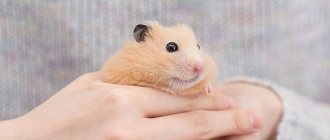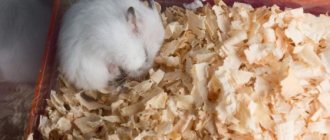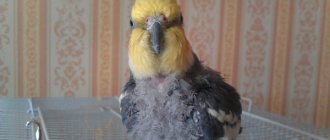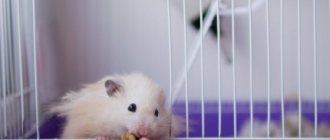Hamsters are active and fairly unpretentious rodents. Recently, they can be found as pets in many families, but, unfortunately, they live very short lives. Therefore, future owners need to be able to determine the age of these rodents before purchasing them. And for this we will find out the basic parameters of hamsters at different stages of life.
Features of coat color and size
The age of the animal is easy to determine by its fur. The cubs are born completely naked, the first hairs on their body appear after five days. After two weeks, babies develop a coat that is thick, shiny, and rich in color. Small hamsters are usually sold to pet stores at one month of age. At this stage of life, their fur coat and skin color are still developing. When buying an animal, you need to carefully examine its fur. If it is short and smooth, then the hamster was born quite recently; if it is long, fluffy, with bald patches on some areas of the skin, then the rodent is an old man. The Syrian cub may exhibit obvious uneven fur color.
Syrian or golden hamster
Behavioral differences
Young Syrian hamsters, like the Djungarians, are active, very active, curious about the world around them, love to play or run in a wheel, and like to stay awake at night. Sometimes they can be a little aggressive. At an older age, they become calmer and more sedentary.
Hair in the ear area
When examining a hamster, you need to pay attention to the condition of the fur near its ears and in the parotid area. In young hamsters, these parts are covered with an even, thin layer of white and fluffy hair. In older individuals, the ears are almost bare, and the remaining hairs on the ears grow noticeably.
Eyes
Young Syrian hamsters have black eyes, slightly bulging and slightly shiny. In healthy hamsters, the mucous membrane of the eyelids is pink and slightly moist.
If the eyes of Syrian hamsters are very shiny, have changed color, are covered with a yellowish film, are sunken, have popped out of their sockets, are dry or very moist, and the mucous membrane of the eyelids is inflamed - this indicates old age or illness of the hamster.
Wool
Syrian hamsters come in short-haired and long-haired varieties.
Long-haired dogs can also be “satin”. Their fur has a satiny sheen.
As they age, the color of Syrian hamsters darkens.
Golden rodents have gray small ears and black bangs. They have this coat color up to 8 months from birth. After 8 months of residence, their undercoats turn gray, but the upper hairs remain golden.
Smoky-pearl colored hamsters have gray fur and beige undercoats. As they get older, their coats may lighten. This is due to a varied diet at home.
Yellow-brown rodents have a rich honey-colored coat. The yellow tint takes up 30% of the total color. A distinctive feature is that these individuals retain their coat color throughout their lives.
Young animals have soft, thick and bright fur, but after two years it becomes hard and sparse.
Weight
The weight of a newborn Syrian hamster is 2-4 grams, and an adult - 100-125 grams. Moreover, their growth in length can reach 13 - 13.5 centimeters.
Dark spots
After one year of life, Syrian hamsters develop black spots on their bodies. They may be on the left and right lower back, as well as around the genitals, or the skin may darken in one patch. These are their glands that darken and become bulging with age.
Lifespan
Syrian hamsters live on average 3 years. If a rodent is provided with good care, it can live for 4 years. Because The average life expectancy of animals is 2 years; Syrian hamsters are classified as long-livers.
Young people are always active and playful
Weight change
A hamster over three months old will usually weigh more than 40 grams unless it is sick. When buying a pet at a pet store, you can ask the seller to weigh it. It is especially important to know the age of the female. Too early or, conversely, late pregnancy can negatively affect her health. At three months, rodents have already reached sexual maturity, but it is still too early for them to mate and give birth to offspring. Having bought a small pet, you need to measure it every week on an electronic scale. Young females, up to four months old, eat well and actively gain weight. The owner should know: if the pet’s body weight steadily increases, then it is a cub; if it practically stops growing, then the female is ready for mating. Mating with a male is allowed only from the age of four months, when the pet reaches normal weight for its species.
Newborn rodents
After giving birth, the female actively protects and protects her cubs. Therefore, she should not be disturbed too much for about two weeks. But at the same time, the owners must examine the offspring. And, if there are dead puppies, they should be removed using a damp cloth.
Babies must be fed mother's milk, which contributes to their rapid growth. They become covered with fluff around the fourth day. And a day later, the animals begin to hear sounds. At the same time, the eyes of young rodents open only on the fourteenth day. But they begin to move actively while still blind.
And by one month the baby’s weight is half the weight of an adult animal. And they grow up to five to six months. And therefore, at six months, a hamster is considered to be a full-fledged adult animal. Since these rodents live very short lives, they begin to age at the age of eighteen to twenty months. If young individuals actively gain weight, their weight can often decrease significantly during the aging process.
Features of behavior
Even a veterinarian cannot tell the age of a hamster with 100% certainty. Quite often, unscrupulous sellers in pet stores pass off old people as babies in order to quickly sell them to uninformed buyers. But how can you determine the age of a hamster so as not to bring home a pet that only has a few days left to live? The surest way is to observe the behavior of animals. Young and healthy rodents are usually active, even playful. The cubs are constantly moving, scurrying around the cage, hanging on the bars, playing around, and eating a lot. Sexually mature individuals swarm around in the feeder or nest, run, fuss, males start fights, and seek the attention of females. But older animals behave more calmly and balanced. They stay somewhat apart from the rest of the inhabitants of the cage, ignore games and fights, eat poorly, but sleep almost all day. Particular attention should be paid to lethargic, indifferent to surrounding events, sedentary animals. Most likely, these are either sick animals or very old people who have very little time left to live. It's not worth buying them. In general, when purchasing a Djungarian hamster or any other, you should not rush, and if you have the slightest doubt, refuse the purchase.
Human and hamster years: how to compare
If we compare human and hamster life years, provided that the average life expectancy of a human is 60-70 years, and that of a hamster is 2-3 years, we obtain the following ratio of their years:
- a hamster 15 days old can be equated to a child 8-10 months old;
- a six-month-old hamster - to a teenager 12-14 years old;
- a two-year-old hamster - to a person aged 50-60 years;
- a three-year-old hamster - to a person aged 70-80 years.
Age of a hamster by human standards
Many owners want to know how old their pet is by human standards. You can do the calculation using the example of the Djungarian hamster. In captivity, a rodent of this breed can live up to three years, with an average life expectancy of two years. The average person lives 60 years. This means that a six-month-old baby hamster is comparable to a twelve-year-old child, and a two-year-old animal is comparable to an elderly person. Therefore, when buying an animal that is only a few months old, you can be sure that it will live a long time. The main thing is to give your pet enough attention, feed it well and take care of its health.
At what age is it better to buy a hamster?
Of course, absolutely any future hamster owner understands that it is better not to buy such a rodent at too young or, conversely, old age.
A baby hamster that does not yet know how to feed on its own will cause its owners a lot of trouble and may even die without maternal care, and an adult pet is unlikely to live long.
The optimal age for purchasing hamsters is 1–3 months. If the owners plan to breed these rodents, you can buy a 6-month-old baby, but it is not recommended to buy a 10-month-old hamster.
At the time of purchase, you need to carefully examine the animal. It should be active, with thick soft fur and shiny, clean eyes.
The life expectancy of hamsters, unfortunately, is low. However, with proper care, they will remain active until the end of their days. These decorative rodents will make wonderful pets for all lovers of small animals.
How to “tame” a hamster
Do not buy a hamster that you have only observed in a cage. Ask the seller to take it out or sit it on a table or counter where you can get very close to it. After placing the animal on the table (or counter), do not try to immediately pick it up. Give him the opportunity to get to know you, offer him food. Everyone knows that the hamster is a very curious animal. He will immediately rush to you to explore what you are offering him. As soon as he gets close to you, start slowly handing him the food. Remember, the hamster is still nervous, so avoid sudden movements. When you are sure that he is no longer frightened by your outstretched hand, turn it palm down and hold it for a few moments so that the animal notices this. Then gently but securely close your fingers around his body. Never grab a hamster unexpectedly - it will probably bite you.
After you have managed to pick up the hamster, examine it carefully according to all the parameters that we discussed with you. If you still can’t pick him up, he still looks scared and tries to bite, choose another animal and try to get along with him.
Transporting your baby home will not be difficult for you. The hamster can be placed in a conveyor, which is usually purchased right there - at a pet store, or simply in a jar. You need to put sawdust or pieces of paper at the bottom to make the hamster feel more comfortable.
Continue reading in the next article...
What determines the lifespan of an animal?
Of course, the number of months lived will affect the pet’s life expectancy, but there are other factors that play an important role, for example:
- breed;
- heredity;
- conditions for keeping the animal before purchase;
- nutrition;
- care.
And if you can’t argue with nature, and we are unable to influence the breed and heredity, then the worthy maintenance of a pet depends only on us.
Even if before the purchase the rodent was not treated in a completely appropriate manner, after the purchase everything depends directly on the owners. Provide your baby with decent living conditions and, perhaps, the animal will live with you for three or even four years.
Age of puberty and reproduction
A happy family.
Starting from the age of 7-8 weeks, hamsters can produce offspring. And although at this age animals can mate and begin to reproduce, you should not plan mating at a young age. It is advisable to wait until the animal matures and gains body weight.
The best age to get your first litter is 3-4 months. It is desirable that by the time of mating the female’s weight is at least 2/3 of the weight of an adult animal.
Females are prone to cannibalism. If she eats all the litter without exception, then such an animal is excluded from breeding.
How to tame a hamster?
Methods for estimating age
Even an experienced ratologist cannot determine the exact age of a rodent. Therefore, the methods presented in the article make it possible to determine the age of a hamster approximately, with errors. All animals can be divided into 3 categories according to age.
- Young.
- Mature.
- Old ones.
Hamsters less than 1 month old cannot eat on their own. The baby will have to be fed from a pipette, with intervals of 2-3 hours between feedings. If you are not sure that you will successfully cope with this task, it is best to refrain from purchasing.
Here are the signs that will help you determine your age.
Behavioral differences
Old and young animals behave differently. The elderly animal is inactive and sleeps a lot. The appetite of old people is much worse than that of young hamsters.
Sexually mature animals are active and do not suffer from lack of appetite. Males can organize “tournaments” to gain the favor of females. The females are busy arranging nests.
The young animal is very active and brings a lot of joy to children with its funny behavior to all family members. The animal's appetite is excellent. Immediately after waking up, he eats and then begins to run around the cage, actively exploring the territory. Kids love to climb the bars of the cage. From the outside it looks touching, but is fraught with injury. Hamsters are gentle animals.
Hair in the ear area
In older animals it is almost completely absent. The ears of young rodents are covered with thin light fur.
Eyes
It is easy to estimate the age of a Syrian hamster or dwarf by the appearance of its eyes. Dull, dull eyes indicate an elderly animal that will not live long. Young animals in good health have shiny eyes. Given good care, such an animal will live, adjusted for the hamster's age, for quite a long time.
Wool
The first signs of hair growth in newborn hamsters appear on days 5-6. The final formation of fur occurs at approximately 2 weeks. The presence of bald patches does not necessarily mean that the rodent is sick. Sometimes these are signs of molting and evidence that the animal is no more than 1 month old. Old people have rough fur. The fur of young hamsters is delicate and soft. Animals arrive at pet stores at one month of age and have short fur. Long hair indicates that the animal is already an adult.
Weight
You can estimate the age of a Djungarian hamster by its mass. During the first 3 months of life, the weight of the animal does not exceed 40 grams. Therefore, before purchasing a pet, you need to weigh it. The ideal age for purchase is from 1 to 3 months. It is advisable to buy rodents from 1 to 12 months.
Females actively gain weight up to 4 months of age. Only when the weight stabilizes (that is, by 4 months), the female is ready to mate and give birth to offspring.
Dark spots
Pigmented seals on the inside of the animal's thighs are a sign of an adult. These spots do not cause any harm to the health of the animal.
Lifespan
How long a hamster will live in a family depends on what kind of animal you bought, young or old. In addition to the initial age of acquisition, life expectancy is influenced by such factors.
- View.
- Features of genetics.
- Living conditions before purchase and quality of care for the animal after purchase.
- Diet quality.
With good care, the dwarf will live about 3 years. The life expectancy of Syrians is 2-3 years. Under natural conditions, rodents live almost half as long due to various dangers (colds, attacks by predators, etc.). Until the age of one month, Djungarians and Syrians do not differ in weight. Only after one month of age do Syrian hamsters begin to gain weight at a faster rate than their counterparts. The average weight of an adult animal is 115 g.
How long can you keep a hamster?
Djungarians are animals that most often desperately need company, so leaving them alone with themselves for a long period of time is highly not recommended. This is also due to the fact that hamsters are incredible gluttons.
They will eat the food you put in the feeder for them until it runs out. In the section below you will find information about how long you can leave your pet without food and/or water.
Without food
According to the recommendations of hamster lovers, it is highly undesirable to leave them without food for longer than 2-3 days. If you intend to go somewhere for a longer period of time, try to find a person who would visit your pet.
You can also try to scatter food throughout the cage in different places and completely fill the feeder with it (so that the animal does not find it all at once) in an amount of 80% of the animal’s weight for each day. In addition, it is necessary to remember that hamsters have special skin pockets in the cheek area, where they can stuff excess food they eat, and then, as the need arises, remove it from there and eat it. This trick will allow the animal to hold out for another day, but then hunger will inevitably set in. Without a crumb of food at all, jungarians can survive for 7–10 days.
Without water
If the lack of food is quite unpleasant, but not at all critical for these animals, then a lack of water can have a fatal effect on the animals’ organisms. Despite the fact that they only drink about 5-7 ml of water per day, Djungarian hamsters absolutely cannot do without it for long periods of time.
Your pet, if you leave it without water, will live no longer than 2-3 days. Therefore, before a long departure, be sure to check the serviceability of the drinking bowl, just in case, put a spare one in the cage, and fill both with fresh, cool water.
So, we hope that this article answered all your questions regarding the life expectancy of Djungarian hamsters. Love your pets, carefully monitor their behavior, try to please them in every possible way, and then manifestations of well-deserved reciprocal love will not take long to arrive.
pets2.me
Keeping a Djungarian hamster
The main procedures for caring for a Djungarian hamster include feeding, cleaning the cage and brushing the fur. True, if you are looking for the most unpretentious rodent, it most likely will not be a dzhungarik. Compared, for example, with its Syrian counterpart, it is much more demanding in terms of care.
The animal needs to eat well. You can feed it grain, fruit mixtures, pea, sunflower, pumpkin, and bean seeds. Please note that representatives of this breed are prone to diabetes, so you should not overfeed them with fruit. But the dzhungarik needs very little water: being a steppe animal, it drinks quite rarely. Nevertheless, a drinking bowl with a small supply of water should be present in his cage.
It is also highly advisable to place a chalk stone in the cage to grind down the teeth.
You can clean the cage about once every two weeks. If you do this less often, the characteristic smell cannot be avoided. The hamster's fur is cleaned with sand. You should never bathe a rodent! This could have a negative impact on his health.
The cage must have a running wheel. This will help your hamster stay in good physical shape. Djungarians are generally very mobile, so they need a fairly spacious cage. However, it is not recommended to keep more than one dwarf in one cage. These rodents are big owners of territory. If you put them together, they will fight and attack each other.
Djungarian hamsters are housed together only temporarily - for reproduction. By the way, this species reproduces very well. There are up to 11 babies in a litter.
At home, the Djungarian hamster lives 1-2 years. With proper care, its life expectancy can be slightly longer. So how long your pet will live largely depends on you.











